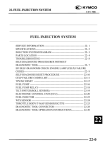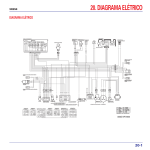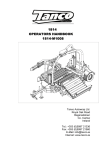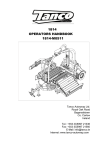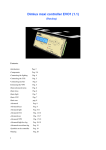Download Tom Bowers` V4 Magna FUEL CUT-OUT
Transcript
Here is a fairly comprehensive description of the 1983 V4 Magna FUEL CUT-OUT RELAY, including almost everything I know about this little demon. There’s also some stuff in here about the ignition system. I’m presenting this information as an aid to anyone else that may be trying to figure out a problem in this part of their own bike. These are my observations and do not necessarily represent what you will observe for yourself. Please don’t cut and paste any portion of this document, rather use this document in it’s entirety for what it’s worth (free) and at your own risk. That disclaimer aside, here’s a little history of how this document came to be. I bought my V45 Magna in March of 1983. I rode a lot that spring and summer, even into the fall until the weather was too cold around the Chicago area. No problems, the bike was perfect! In the spring of 1984, this little demon showed up. The bike was impossible to start after sitting all winter. Eventually, I figured out that there wasn’t any fuel in the carburetor bowls. And, the fuel pump wasn’t pumping, so I jumped battery to the pump, listened while it filled the bowls and then stopped pulsing. I put the plug back in place for normal connections to the pump and the engine started right up. Weird, I thought to myself, but throughout the summer everything was fine, so I forgot about it until the spring of 1985. Same problem! What’s up with Honda?? I’m thinking. They wouldn’t have purposely made this thing so you have to drive it every day would they?? Well, they sort-of did. To make matters worse, the low speed jet is so small in each carburetor that it gums up easily if left sitting too long with old fuel to evaporate. After a few years, there were two problems, no fuel in the bowls after parked, and hard starting / lack of idle due to the low speed jets being clogged. After removing the carburetor assembly the first time, I realized that I was not the little Japanese girl who had built this thing the first time, my hands are just too big! And, I did it that first time without removing the radiator, which I have since learned is a real big help. Cleaning the low speed jet is easy with an acetone soak and some really small wire, like you would find in a frayed lamp cord. You just need to be really careful not to ream out the jet hole size. So, back to the original intent of this story. I traced the wiring to the fuel pump in the schematic and had some problems because I believed the schematic from the Honda service manual to be correct (foolish me, more later). Unable to make sense out of it, I took the brute force approach and intervened at the inputs to the fuel pump. I added a double pole, double throw switch rated for 15 amps in series with the two fuel pump wires, so that the common contacts were connected to the fuel pump. One set of switched contacts were connected to the original circuit so that when the switch was in that position, the wiring was as originally manufactured. The other set of contacts went directly to ground and battery through a new inline fuse. And, I used a center off switch so that in this “OFF” position, I could run the engine to drain the carburetors. This proved useful because it didn’t leave any fuel in the low speed jets to gum up over the winter. I still opened the drains to really get rid of the last few drops, but having the engine suck the last bit out of the jets is also useful. “The Fuel Cut-Out Relay” Since I recently brought this 1983 V45 Magna out of storage, and joined Sabmag, I’ve seen lots of interest in this little “relay”. As some of you already know, it’s not really a relay. It’s an electronic circuit that senses the presence of pulses between one of the spark units and it’s associated ignition coil. If these pulses are present, this circuit energizes the fuel pump. The fuel pump is a solenoid operated diaphragm with inlet and outlet one way valves. When there is no back pressure on the pump (empty carburetor bowls), the solenoid pulls the diaphragm in, drawing fuel from the inlet check valve, and also opening a contact so that the solenoid circuit is then de-energized. Then, a spring pushes the solenoid armature and the diaphragm back to the original position, discharging fuel through the outlet valve. The contact closes. This cycle repeats until the carburetor bowls are filled, assuming the +12 volt power remains. But, when you are trying to start the engine after things have been stored for a while, two things work against you. The engine won’t start without fuel and it’s probably spring, cold weather, so you need extra fuel for the choke circuits, and the battery is probably weak because you forgot to store it properly. You guys already know all this, but I hope the electrical / mechanical description of the pump helped some of you understand it a little better. Back to the Fuel Cut-Out Relay. This circuit consists of a Silicon Controlled Rectifier (SCR), which acts like a switch. This SCR is in series with +12 Volts and the fuel pump solenoid circuit. If the SCR is triggered, it passes +12 Volt power to the fuel pump solenoid and continues to pass this current until the fuel pump contact opens. Then, the SCR resets and no more power is passed until the SCR is triggered again. That’s just how SCRs work. A pulse from the ignition coil generates the SCR trigger signal, so as long as the engine is running, the SCR gets triggered and the pump gets power. The original problem that led me to this circuit is that when the carburetors are dry, the pump can’t prime the bowls fast enough to get the engine to start with a weak battery and without lots and lots and lots more cranking. In my 1983 V45 Magna, the Fuel Cut-Out Relay is located under the fuel pump, behind the battery, and to the left and behind the fuel cut-off valve. It’s a black box about 1 inch by 1 inch by 2 and a half inches with a white connector at one end connecting three wires. I have to remove the right fuel pump mounting bolt so I can move the fuel shut off valve out of the way to get to the Fuel Cut-Off Relay. Yours may be different. The original Honda service manual schematic is incorrect in the way it shows the wires to this Fuel Cut-Out relay, The Blue and Black wire positions are swapped in the schematic from how these are really built. My schematic is labeled 0030Z-MB1-6700 in the lower right corner. Fuel Pump BATTERY (This big white thing) Fuel Shut Off Valve Fuel Cut-Out Relay To get the Fuel Cut-Out Relay out of there, I had to remove the left side fuel pump mounting bolt, which also holds the Fuel Shut Off valve mounting bracket. Then I dropped the bracket down and left the bolt in place. Then I could pull out the Fuel CutOff relay. See below: Fuel Pump Bolt Removed Shut Off Valve & Bracket Fuel Cut-Out Relay Rear Tire BATTERY Note that from this view, the wires are (Left to Right) Blue, Black, White. (Ignition, +12 Volts, Output) Circuit details: The fuel pump solenoid measures about 2.1 ohms on my 1983 V45 Magna. It takes a reasonably good VOM to measure this, but I can do this test with a meter that’s on sale at Harbor Freight for $2.99 from time to time. You just need to measure the difference between the lead resistance of the meter and the lead resistance plus the pump. A shorted pump solenoid or wiring harness will blow up the SCR in the Fuel Cut-Out Relay circuit. And, an open contact or solenoid won’t ever pulse. If you are having problems with fuel delivery, start by putting a jumper between the black and white wires on this Fuel CutOut relay connector and then turning on the ignition key. The pump should pulse if it is OK and it will blow the fuse if it is shorted. If nothing happens, the contact in the pump is bad or the pump solenoid coil is open. So, if it blows the fuse, or does nothing, the pump is bad. If it pulses until the carburetor bowls are full and then stops, the pump is normal and the problem is in the Fuel Cut-Out Relay. If nothing happens, make sure the carburetors aren’t full and the pump isn’t pulsing because there is no need for fuel. You can open a bowl drain to test for this. Here is a complete schematic for the Fuel Cut-Out Relay and Fuel Pump. I haven’t actually seen inside a fuel pump, so this part is just a guess. Pete sent me some pictures of a Fuel Cut-Out relay circuit board so I traced the connections and came up with this schematic. The actual resistor and capacitor values are subject to further verification, but the circuit shown should be accurate otherwise. Since I haven’t actually seen inside a pump, I don’t know much about the diode across the solenoid, but I’m confident it could be replaced if you have inadvertently connected power backwards and blown up this diode. Here’s how it works: The starting conditions are that the fuel pump armature is down, as positioned by the spring, the carburetors need fuel, and the pump armature contact is closed. +12 Volts is present at the Black wire into the Fuel Cut-Out Relay circuit. The engine is cranked by the starter or is running so an ignition pulse is generated as an input on the blue wire. This triggers the SCR and power is passed through the SCR to the pump solenoid. The solenoid remains energized until it travels far enough to open the pump solenoid contact. Then the coil is de-energized by the armature contact and the SCR resets. The diode in the pump clamps the inductive voltage spike so that the contact doesn’t arc, preserving the contact to work again next cycle. When the armature contact closes at a later time, the SCR is reset and doesn’t power the solenoid until a subsequent ignition pulse occurs, starting the cycle over again. Here’s an oscilloscope trace of the pump pulsing when a jumper is in place from the Fuel Cut-Out Relay Black wire to White wire. (Fuel Cut-Out Relay bypassed) Trace 1 (Black waveform) is the solenoid current at 1 Amp per division, so the coil current rises to about 3.2 amps. The full stroke of the pump armature takes a little less than 30 milliseconds. Traces 2, 3, and 4 will be more useful in subsequent photos. This is an oscilloscope trace showing the engine idling (about 1200 RPM). Waveform 1 (Black) is the pump solenoid current at 1 Amp per division. Waveform 2 (Green) is the pump solenoid voltage as supplied by the Fuel Cut-Out Relay Waveform 3 (Red) is the +12 Volt power to the circuits Waveform 4 (Blue) is the Ignition input on the blue wire. The solenoid current waveform is pretty similar to the previous picture, except it’s only conducting for about 22 milliseconds, because the voltage is higher from the battery being under charge, so the armature moves faster. You can see the voltage drop across the SCR as it carries this current. The voltage rise to +12 Volts on waveform 2 (Fuel Cut-Out Relay OUTPUT) is the result of the SCR being triggered ON by the ignition coil input pulse (waveform 4, blue). Subsequent ignition cycles try to fire the SCR but the solenoid contact is open so there isn’t any current flow and the SCR resets when the trigger signal goes away. Here’s another view of the same setup, except the engine is reving to about 4000 RPM. The solenoid current waveform (trace 1, black) is similar to above. Waveform 2 (Green) shows the Fuel Cut-Out Relay output where the SCR stays triggered as long as there is a current draw from the solenoid, and then the voltage starts to follow the ignition trigger when the solenoid contact opens. Waveform 3 (Red) shows a similar drop in the +12 Volt supply only when the solenoid is energized. Waveform 4 (Blue) shows the ignition coil primary voltage, now at about 4000 RPM. The next picture isn’t really related to the fuel pump circuits, but shows the ignition circuit instead. I figured, it’s connected to the scope, let’s show some more details of how this works. This photo (below) shows just the leading edge of the voltage pulse between the spark unit and the ignition coil primary. It’s expanded from this point in the above photo. Note that the time-base is now 10 microseconds per division instead of 10 milliseconds as above. The ignition coil primary voltage is developed across the primary winding. One end of this winding is at +12 Volts and the other end of this winding is connected to the collector of a transistor with it’s emitter grounded. When this transistor is on, current builds up in the primary circuit, building up an associated magnetic field. When the transistor turns off, the magnetic field collapses, creating a large voltage spike, which in turn fires the spark plugs for those two cylinders. This magnetic field collapsing also generates a fairly high voltage on the primary circuit. As you can see, this reaches 428 volts peak. This is the voltage on the primary winding. If multiplied by the turns ratio of the ignition coil, you could determine the secondary voltage needed to fire both spark plugs which are in series. Changing the plug gap, fuel/air ratio, engine load, altitude, etc. will change the spark voltage, so this is just a single observation of my setup today. Your similar measurement would most certainly be somewhat different. But the general waveform shape and timing should be consistent. It’s this large positive going pulse that triggers the SCR to energize the fuel pump solenoid any time there is a fuel demand. Conclusion: That’s pretty much what I know about this topic, I hope it’s been worth the read.










